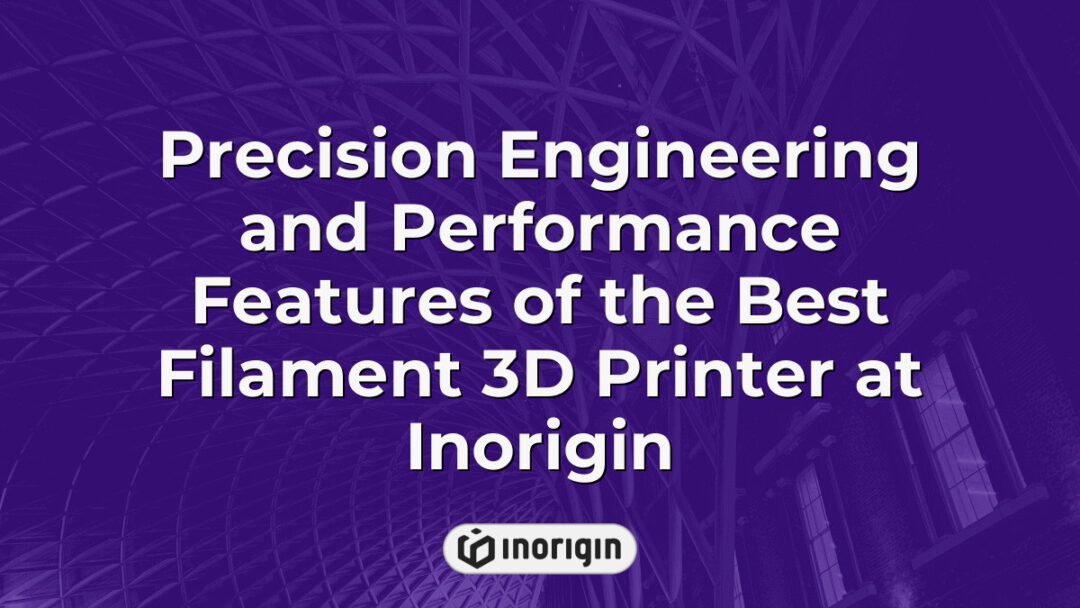In the rapidly evolving landscape of additive manufacturing, the quest for the best filament 3D printer emerges as both a technical and creative odyssey, capturing the imagination of hobbyists and professionals alike. As the foundation of numerous innovations, the choice of filament printer holds the potential to transform mere concepts into tangible realities, akin to an artist wielding a brush to bring a blank canvas to life. With a plethora of options available, ranging from budget-friendly models to advanced industrial machines, this exploration seeks to delineate the attributes that define superior performance, versatility, and usability, thereby guiding practitioners toward making informed decisions in their pursuit of excellence in 3D printing.
| Aspect | Key Takeaway |
|---|---|
| Importance of Filament Printer | The best filament 3D printer is crucial for converting innovative design concepts into precise and functional physical prototypes or final products. |
| Key Selection Criteria | Choosing a filament printer involves evaluating filament compatibility, print resolution, ease of operation, and maintenance demands to match specific project needs. |
| Filament Material Options | Different filaments like PLA, ABS, PETG, and advanced composites offer unique strengths and applications, influencing print durability and detail. |
| Maintenance Best Practices | Routine cleaning, careful filament storage, and precise calibration extend printer lifespan and ensure consistent high-quality output. |
| Commercial and Industrial Use | Filament 3D printers provide versatile and cost-effective solutions for rapid prototyping and production in various industries, including automotive and healthcare. |
| Emerging Applications | Flexible filaments enable novel engineering applications such as customized prosthetics and soft robotics, expanding the scope of additive manufacturing. |
| Safety Considerations | Proper ventilation, protective equipment, and regular equipment checks are essential to ensure safe and reliable operation of filament 3D printers. |
Top Filament 3D Printers in the Market
The world of 3D printing technology can be likened to a vast ocean, where the search for the best filament 3D printer becomes an expedition fraught with both promise and peril. With an ever-expanding array of options, discerning the top filament 3D printers in the market necessitates careful consideration of several key elements, including compatibility with various filament types and the efficiency of the printing process. Bambu Lab, for instance, has emerged as a significant player in this field, known for its ability to produce high-quality prints with minimal warping and superior adhesion. Additionally, other brands have begun to broaden their portfolios by developing printers that not only accommodate a diverse range of 3D printer filaments but also optimise user experience with advanced features like automatic bed levelling and responsive customer support. When evaluating the landscape of 3D printers, it becomes evident that factors such as build volume, speed, and print resolution must also be taken into account to select the most suitable device that meets the specific needs of diverse users, from hobbyists to professional engineers. The insights gained through scrutiny of these devices reveal that the right choices can foster creativity and facilitate innovation, turning mere ideas into tangible realities.
Factors to Consider When Choosing a Filament 3D Printer
Choosing the right filament 3D printer can sometimes feel like an overwhelming journey through a maze of options, each more enticing than the last. However, rather than becoming lost in confusion, a clearer path emerges once essential factors are thoughtfully examined. Firstly, the compatibility of the printer with various types of filament, such as PLA, ABS, or PETG, is crucial, as different filaments offer distinct properties and performance metrics. Secondly, the print quality, often gauged by nozzle diameter and layer resolution, plays a significant role in determining the overall output, with tighter tolerances generally yielding smoother finishes. Thirdly, the ease of use, which encompasses everything from setup to maintenance, can greatly influence the user experience; simpler machines can be more accommodating for beginners. Considering these factors aids in making an informed decision that effectively aligns with specific project requirements and preferences. When all is said and done, a thorough evaluation of these aspects can lead to a more satisfactory engagement with the world of 3D printing, ultimately enhancing creativity and productivity.
Comparison of Popular Filament Materials
When comparing popular filament materials for 3D printing, several key options emerge, each with unique characteristics and applications. Polycarbonate, for instance, is well-regarded for its extraordinary toughness and heat resistance, making it suitable for functional prototypes and mechanical parts. On the other hand, Fiberology PA12CF represents a notable advancement in the realm of composites, integrating carbon fibres into nylon, which enhances strength and rigidity while maintaining relatively low weight; this makes it particularly appealing for engineers seeking durable printing solutions. In contrast, Polymaker CF PLA offers a compromise between ease of use and enhanced mechanical properties, with the addition of carbon fibres to standard PLA providing a visually appealing finish alongside improved strength characteristics. As such, the choice of filament ultimately depends on the desired application, whether that be for high-stress environments or intricate, aesthetically pleasing designs; understanding the nuances of these materials can significantly impact the success of a 3D printing project. The selection process should carefully consider the specific requirements of the intended use case, as each material presents distinct advantages and trade-offs.
Maintenance and Troubleshooting Tips for Filament 3D Printers
Maintenance and troubleshooting in filament 3D printers encompasses several integral aspects that contribute to sustained performance and productivity. Ensuring optimal function requires attention to critical areas including regular cleaning, appropriate storage of filament, and meticulous calibration of print settings. Firstly, regular cleaning of both the printer’s nozzle and build platform can prevent common issues such as clogging and adhesion failures, which ultimately disrupt the printing process. Secondly, proper storage of filament is essential; maintaining an environment that guards against moisture exposure helps preserve the filament’s integrity, essential for achieving durable functional prints. Lastly, precise calibration of print settings—such as temperature, speed, and layer height—can significantly influence the quality, strength and aesthetic of finished products.
A three-item numeric list emphasises three key maintenance tips:
1. Clean the nozzle and build surface regularly to avoid clogs and ensure adhesion.
2. Store filament in airtight containers with desiccants to prevent moisture absorption.
3. Regularly calibrate temperature, speed, and other print settings to optimise print quality.
Given the intricacies involved in filament management, understanding these maintenance protocols is fundamental, as they play a crucial role in preventing common issues while optimising the printing experience. Frequent monitoring and adjustment of these factors allow users to effectively mitigate potential problems before they escalate. A proactive approach not only leads to improved output quality but also extends the lifespan of the printer itself, making the process all the more efficient in a fast-paced production context. Such diligence ultimately culminates in higher quality prints that meet functional requirements and user expectations.
Innovative Applications of Filament 3D Printing
In recent years, approximately 70% of professionals in the additive manufacturing sector have explored the utilisation of flexible filaments, reflecting a significant trend in the innovative applications of filament 3D printing. As industries continue to seek more versatile materials, these flexible filaments have emerged as a solution to challenges associated with traditional materials, such as rigidity and limited functionality. Noteworthy applications are surfacing across various sectors, ranging from medical devices like customised prosthetics, which can be tailored for individual patients, to automotive components that require resilience and adaptability under diverse conditions. Transitioning from traditional manufacturing processes to 3D printing not only reduces material waste but also accelerates production timelines; thus, organisations can develop prototypes and end products much quicker. In addition, innovative applications such as the creation of complex geometries in soft robotics demonstrate how flexible filaments are redefining engineering strategies. This intersection of material science and technology underscores the transformative potential of 3D printing, as businesses and researchers alike continue to explore ever-new uses for these advanced materials. The momentum gained within the industry raises intriguing questions about future possibilities, inviting further enquiry into how flexible filaments might reshape manufacturing paradigms.
Frequently Asked Questions
What is the average lifespan of a filament 3D printer?
The average lifespan of a filament 3D printer typically ranges from three to five years, although several factors can influence this duration. Firstly, the type of printer and its build quality play a significant role; high-end models often incorporate more durable components, which can extend their operational life. Secondly, maintenance practices are crucial; regular cleaning, proper temperature settings, and timely repairs can mitigate wear and tear. Furthermore, the frequency of use is another determining factor; printers subjected to frequent operation and heavy workloads may experience a shortened lifespan compared to those used sparingly. Also, users should consider the type of filament employed, as some materials may produce residues that could affect the printer’s longevity. Therefore, understanding these variables can assist users in optimally utilising their filament 3D printers and potentially extending their life expectancy.
Can filament 3D printers be used for commercial purposes?
The application of filament 3D printers for commercial purposes has gained significant attention in recent years due to their versatility and cost-effectiveness. These devices, which extrude thermoplastic materials layer by layer to create three-dimensional objects, serve a wide array of industries—ranging from prototyping and manufacturing to education and art. To better understand this trend, several factors warrant consideration. First, the availability of a variety of materials—such as PLA, ABS, and PETG—enhances the potential for creating tailored products. Second, advancements in printer technology have led to improved precision and reduced printing times, making it feasible to meet commercial demands effectively. Third, the increasing accessibility of 3D printing technology, coupled with reduced costs, allows small businesses to enter the market without massive initial investments. Finally, industry regulations and standards are evolving, which may affect the extent to which these printers can be utilised in certain sectors, particularly in health and safety-critical applications.
For those contemplating the commercial viability of filament 3D printers, the following points should be highlighted:
1. Diverse material selection allows for application in various fields.
2. Enhanced accuracy and speed of printing facilitate efficient production cycles.
3. Lower investment costs democratise access for entrepreneurs and small enterprises.
4. Growing regulatory frameworks can impose challenges but also encourage best practices.
In light of these considerations, the suitability of filament 3D printers for commercial applications is underscored by their multifaceted capabilities and the shifting paradigm within industrial sectors. As technology continues to develop and user comprehension increases, these printers could well redefine manufacturing norms while fostering innovation across diverse industries.
What are the safety precautions for using filament 3D printers?
Using filament 3D printers undoubtedly presents some challenges, especially when it comes to safety precautions, yet it is amusing to think that such innovative technology might also demand a meticulous approach to avoid mishaps. First and foremost, individuals operating these machines must ensure that workspaces are well-ventilated. This is crucial since various filaments, especially those containing ABS, can release fumes that some may find unpleasant or even harmful. Furthermore, thermal hazards cannot be overlooked; these printers typically operate at high temperatures, and the risk of burns from hot components is significant. As a result, protective gear, such as heat-resistant gloves, is not merely an accessory but an absolute necessity. In addition to this, the importance of regular maintenance can’t be stressed enough. Regular checks on parts like the extruder and heated bed help prevent malfunctions that could lead to fires or other dangerous scenarios. Age becomes a factor too; older printers may pose unforeseen risks. The overarching narrative, nonetheless, suggests that with adequate precautions, the creative potential unleashed by filament 3D printers need not be overshadowed by fears of safety hazards.
Conclusion
In conclusion, the landscape of filament 3D printing presents a plethora of opportunities for creative expression and technological advancement. By carefully navigating the myriad of choices and understanding the intricacies of materials and maintenance, users can construct a gateway to innovation, transforming visions into tangible realities with remarkable precision.
Related posts:
- Commercial 3D Printer Capabilities Driving Innovation in Product Design and Engineering
- Quality 3D printer filament near me for professional-grade printing projects
- Filament 3D Printer Advantages for Precision Engineering and Advanced Product Design
- 3D printer filament types That Enhance Strength, Flexibility, and Finishing for Professional Prototypes
- 3D printing filament options tailored for advanced prototyping and product design innovations
- Advanced 3D Print Filament Properties and Sustainable Options for Precision Prototyping




